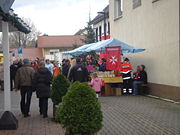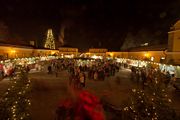Christmas market
A Christmas market, also known as Christkindlmarkt, Christkindlesmarkt, Christkindlmarket, and Weihnachtsmarkt, is a street market associated with the celebration of Christmas during advent, mainly the four weeks preceding Christmas Day. These markets originated in Germany and Austria but are now being held in many other countries.
Contents |
History
The history of Christmas markets goes back to the Late Middle Ages in the German speaking part of Europe. The Dresden Christmas market - first held in 1434 is often (incorrectly) said to be the oldest Christmas market. It attracts between 1.5 and 2 million visitors a year and has over 60 stalls.[1] It is very unlikely that Dresden market is really the oldest as the city was a small town in 1434 and other cities earned market rights. One example is Bautzen Christmas market which was first mentioned in records in 1384.[2] The Vienna "December market" was a kind of forerunner of the Christmas market and dates back to 1294.
In many towns in Germany and Austria, Advent is usually ushered in with the opening of the Christmas market or "Weihnachtsmarkt". In southern Germany and Austria it is also sometimes called a "Christkind(e)l(s)markt" (South Ger., literally meaning "Christ child market"). Generally held on the town square and adjacent pedestrian zones, the market sells food and drink from open-air stalls with other seasonal items and traditional singing and dancing. On opening nights (and in some towns more often) onlookers welcome the "Christkind", or boy Jesus, acted out by a local child.
Attractions and stalls
Popular attractions at the market include the Nativity Scene (a crèche or crib), Zwetschgamännla (figures made of decorated dried plums), Nussknacker (carved Nutcrackers), Gebrannte Mandeln (candied, toasted almonds), traditional Christmas cookies such as Lebkuchen and Magenbrot (both forms of soft gingerbread), Christstollen (Stollen), a sort of egg bread with candied fruit, Bratwurst, and for many visitors one of the highlights of the market: Glühwein, hot mulled wine (with or without a shot of brandy), or Eierpunsch (an egg-based warm alcoholic drink). Both help stave off the cold winter air which sometimes dips below freezing. Many other handmade items, toys, books, Christmas tree decorations and ornaments (and in recent years less useful gadgets) can be found at a Christkindlmarkt..
Markets around the world
- See also: List of Christmas markets
Famous Christmas markets are held in the cities of Nuremberg, Dresden, Stuttgart and Augsburg making them popular tourist attractions.[3][4] The Nuremberg and Dresden markets draw about two million people each year; the Stuttgart market attracts more than three million visitors.
Strasbourg, France has been holding a Christmas market, "Christkindelsmärik," around its cathedral since 1570, when it was part of the Holy Roman Empire of German Nation.[5]
Christmas markets are traditional in Alsace (an area of France with a heavy German influence) and most of the towns have their local Christmas market. Large Christmas markets are held in Leeds and Birmingham, England, with visiting traders from Frankfurt.[6] These markets claim to be the biggest continental-style Christmas market outside Germany and Austria with over 90 stalls in 2007. Glasgow, Manchester,[7] Lincoln and Nottingham also hold similar markets. German immigrants also brought the Christmas market celebrations to the United States.[8][9][10][11][12]
See also

- Christmas
- List of Christmas markets
- Strasbourg cathedral bombing plot
Christmas Market Gallery
References
Further reading
- Bakst, Alex. "A Visit to Germany's Christmas Markets", Spiegel Online, December 7, 2006.
- Zug, J.D. (1991). German-American Life: Recipes and Traditions. Iowa City: Penfield Press.
Notes
- ↑ Schiller, M. (2007). 573 Striezelmarkt in Dresden. Retrieved July 8, 2007, from http://www.striezel-markt.de/
- ↑ 623. Bautzen Christmas market, from http://www.weihnachtsmarkt-deutschland.de/weihnachtsmarkt-bautzen.html
- ↑ Stadt Nürnberg. (Unknown last update.). Christmas City Nuremberg. Retrieved July 8, 2007, from http://www.christkindlesmarkt.de/english/
- ↑ Stuttgart Marketing. (Unknown last update). Stuttgart Christmas Market. Retrieved July 8, 2007, from http://www.stuttgart-tourist.de/ENG/leisure/weihnachtsmarkt.htm
- ↑ Noël à Strasbourg. (Unknown last update). Noël à Strasbourg. Retrieved July 8, 2007, from http://www.noel-strasbourg.com/
- ↑ Birmingham City Council. (2007, October 9). Frankfurt Christmas Market in Birmingham. Retrieved December 1, 2007, from http://www.birmingham.gov.uk/GenerateContent?CONTENT_ITEM_ID=28153&CONTENT_ITEM_TYPE=0&MENU_ID=12745
- ↑ Manchester City Council. (2007, November 8). Manchester City Council - Christmas Markets - Feeling Festive?. Retrieved November 8, from http://www.manchester.gov.uk/site/scripts/documents_info.php?documentID=1654
- ↑ ArtsQuest. (2006). CHRISTKINDLMARKT BETHLEHEM. Retrieved July 8, 2007, from http://www.christkindlmarkt.org/
- ↑ German American Chamber of Commerce of the Midwest. (2006, November 17). Christkindlmarket Chicago. Retrieved July 8, 2007, from http://www.christkindlmarket.com/facts.htm
- ↑ German American Chamber of Commerce Colorado Chapter. (2006). Denver Christkindl Market. Retrieved July 8, 2007, from http://www.denverchristkindlmarket.com/
- ↑ http://www.mifflinburgchristkindlmarket.com/
- ↑ German-American Society of Tulsa. (2007, May 1). Christkindlmarkt 2007. Retrieved July 8, 2007, from http://home.att.net/~gastulsa01/Christkindlmarkt.htm
External links
- Berlin Christmas markets
- Munich Christmas markets
- Web Online Exercise about Christmas Markets in Germany
- Listing of UK and European Christmas Markets
- Christkindlesmarkt Augsburg [1]
- Full list of German Christmas Markets
|
||||||||||||||||||||||
Christkindlesmarkt
The „Nürnberger Christkindlesmarkt“ is a Christmas market and takes place annually in advent in the old town of Nuremberg at the “Hauptmarkt”, the central place in Nuremberg’s old town, and in all the adjoining streets and places. Two millions visitors going there every year make the “Nürnberger Christkindlesmarkt” to one of the biggest Christmas markets in Germany and to one of the most famous ones in the world. Every year the Christmas market begins on the Friday preceding the first Sunday in advent and ends on 24th December, unless this day is a Sunday.
History
Despite intense investigations carried out by several historians and country researchers, the origins of the “Nürnberger Christkindlesmarkt” are unknown. The oldest piece of evidence, however, is a box made of coniferous wood on whose bottom stands the following inscription: “Regina Susanna Harßdörfferin of the virgin Susanna Eleonora Erbsin (or Elbsin) sent across for the “Kindles-Marck” 1628. At the moment this box is in the possession of the Germanic National Museum in Nuremberg.


